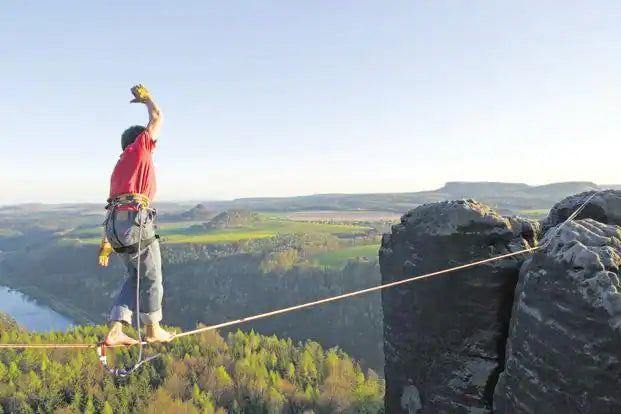Awesome report By Planetmountain
“The people who walk on air” by Sohini Sen
Look ahead. Focus. Heel in, toes out”. These are the instructions I can hear as I walk towards a group of young men who suspiciously look like they are floating in mid-air. In reality, the group is practising slacklining—a sport where people attempt to walk on a strip of webbing fixed above the ground, but not stretched enough to make it taut.
“The sport is still young in India. Most people confuse us with tight-rope walking—where the rope is taut and you carry a stick to help you balance. Sort of what we would see in acrobatics or even in road-side stunts, etc. Slack is more about using your core muscles and concentrating to get from one point to the other, on a not-so-stable line,” says Mohit Tanwar, 32, the admin of Delhi-based Facebook group Slacktivism. Slacktivism was started five years ago by German slacking enthusiast Enrico Fabian when he was living in Delhi, as a community for slacklining enthusiasts to meet, practise and share ideas. Now, the group has 1,900 members, most of whom are Delhi-based. On weekends, in south Delhi’s Deer Park, you will see Slactivism members practising. The Saturday sessions typically see fewer members come out, but on Sundays, around 20-30 people can be seen taking turns walking on the lines.
They generate quite a bit of interest—there are children as young as 7 who have walked up to the group and given it a go. Then there are passers-by who hang around to see what is happening. The members are mostly the outdoorsy type—people who have been athletes, or have been involved in other adventure sports such as trekking, rock climbing or bouldering. The sport works majorly on the core, with slackliners walking a 100-200ft line for around 10 minutes. Imagine doing crunches continuously for that long—that is the amount of work your core has to undertake. This works on hips and knees as well. But most importantly, it helps improve concentration.
“It is a superb mental activity. Initially you may fall from the line in 2-3 seconds, but once you can balance, it becomes a complete game of concentration. Beginners are often asked to stare intently at one point ahead to keep their balance. But as you improve, it helps to develop a ‘soft’ concentration also,” adds Tanwar.
Slacklining, it is said, was thought up by a rock climber. It is popularly used by climbers on days when they want to rest, or work on their lower bodies while giving their arms a break. Tanwar, too, is a climber and tried it out two years ago. Ever since, he has been practising in the park—gradually moving to longer lines, and with more control.
Tanwar is often joined by Archit Rakheja, 31. Rakheja has always been into sports, but it was the first slacklining session five years ago that threw him completely off balance. “I have always been an active person. Playing sports and practising martial arts. But when I tried this, I could not control myself on the line for even 5 seconds. Maybe that initial shock of not being able to do something made me push myself harder and now I am here, even when it is raining. Actually, especially when it is raining,” says Rakheja.

